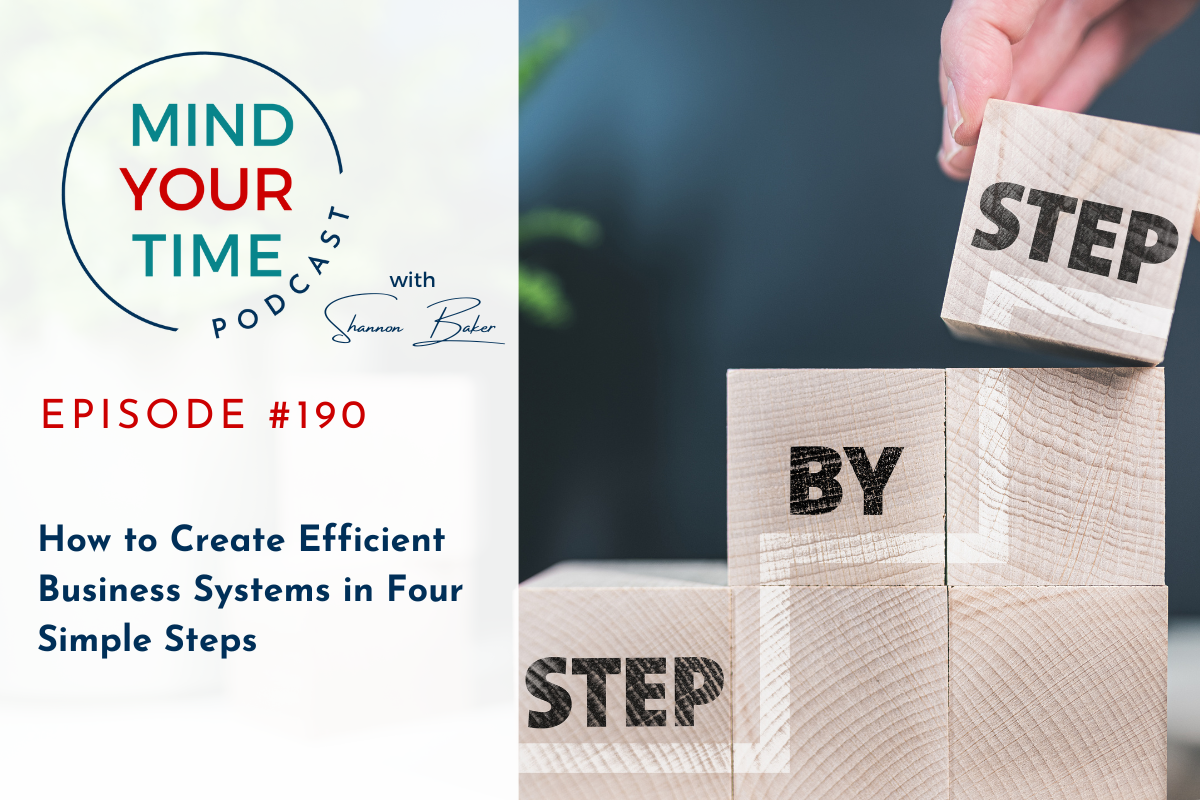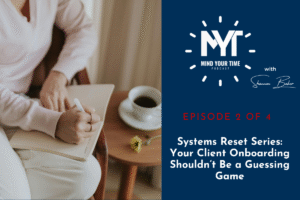When was the last time you felt like you were in control of your business instead of it controlling you? If you’re juggling every task and barely keeping up, it’s time to stop hustling harder and start working smarter by creating efficient business systems.
In this post, I’m walking you through four simple steps to help you create basic business systems that will save you time, reduce stress, and bring clarity to how your business operates. Whether you’re just starting or you’ve been in the game for years, these steps will help you run a business that supports you—not the other way around.
Step 1: Identify Your Bottlenecks
The first step to creating efficient business systems is identifying where things feel stuck or overwhelming. Are you spending too much time answering emails? Losing track of client onboarding tasks? These pain points are your “bottlenecks,” and they’re costing you time and energy.
Think of them like leaks in your business. If you discovered a leaky roof, you’d fix the biggest holes first, right? The same goes for your business. Focus on the areas that cause the most frustration, and don’t be afraid to take a hard look at how you’re managing things.
Step 2: Document Your Processes
Documentation may sound tedious, but it’s a game-changer for building efficient business systems. Start small—with a simple checklist. For example, pilots and doctors use checklists to ensure every step of a process is accounted for, and you can do the same for your business.
Tools like Loom allow you to record your process visually, creating an invaluable training resource when you’re ready to delegate. Or, if video feels like too much, try using a voice recorder on your phone. You can upload it to Otter.ai or Rev for transcription, giving you a text version to refine.
Inside the MY-T Society membership, we take documentation to the next level with tools like the How to Map Out Your Process in 5 Steps workbook. This makes the process simple and ensures your systems are clear, actionable, and ready for anyone to follow.
Step 3: Test Your Systems
Once you’ve documented your processes, it’s time to test them. This step is critical to creating truly efficient business systems. Have someone on your team (or even a business peer) follow your process without your guidance.
Testing ensures your documentation is clear and reveals any gaps you need to address. It also gives you peace of mind that your systems can run without you holding them together. This step may feel tedious, but the long-term payoff is massive.
Step 4: Refine and Improve
Finally, remember that systems aren’t static—they need to evolve as your business grows. Block time on your calendar at least twice a year to review your processes, refine them, and make improvements.
If you have a team, involve them in this process. Their insights are invaluable since they’re the ones working with your systems daily. Not only does this create stronger systems, but it also builds buy-in and engagement from your team.
Inside the MY-T Society, the Entrepreneurial Journey Roadmap helps you track your progress and make necessary tweaks to your systems, so your business keeps running efficiently and effectively.
Creating efficient business systems is about more than just saving time—it’s about reclaiming your freedom and running a business that aligns with your goals and values. When you have systems in place, you’re no longer the bottleneck, and your business can thrive even when you step away.
Whether you’re building your first system or refining an established one, these four steps will help you build a business that supports your life, not the other way around.
If you’re ready to stop spinning your wheels and start creating systems that work for you, check out MY-T Society for resources, tools, and a community that will support you every step of the way.
If you would like to hear the expanded version check out the podcast episode below.
1:36 – Why building systems is crucial for creating freedom, focus, and efficiency in your business
3:02 – Explanation of how systems provide consistency and stability, making your business independent of your constant involvement
5:15 – Introduction to the four steps for building foundational systems that save time and increase efficiency
8:45 – Two methods for documenting processes that you can consider to help make this an easy lift
14:06 – Insight into how implementing systems can transform your business, supporting your lifestyle and giving you back time and peace of mind
Hello, and welcome back! If you caught our bonus episode earlier this week, you know we got real about why things can feel so overwhelming when there aren’t systems in place. Today, we’re diving straight into the “how”—breaking down exactly how to start building those systems so you can experience more freedom, clarity, and efficiency in your business.
And a quick heads-up: my flash sale on MY-T Society is happening tomorrow! If you’re ready to make that shift and start putting the systems we’re talking about into action, you won’t want to miss it.
Alright, let’s jump into today’s steps and get you set up for success!
Did you catch our bonus episode earlier this week? If not, no worries—I’ll get you up to speed really quickly because today, we’re going to talk about the steps you need to follow to create your business systems. But I do recommend you go back and listen to the episode where I highlight the common fears that hold entrepreneurs back from creating their business systems and how to push through them. I’ll put a link to that in the show notes for you.
I decided to do these two episodes in the same week because I know how easy it is to be juggling all the pieces just to keep things moving in your business and how hard it is to stop doing that. But the good news? Today, we’re breaking down how to start building the systems you need to create more freedom, focus, and efficiency in your business and end the juggling act. One of my mentors always says “Only clowns juggle.” And we’re business owners not clowns. So where do we start this transformative process after we change our mindset?
It starts with a clear understanding of what systems are and why they’re so essential. As the SheEO of your business, you need to fully understand what I mean when I say “systems” and how they’re designed to support, not stifle, your ability to lead effectively.
A system is the combination of three elements that work together to perform a specific task: a step-by-step process, the tools needed to automate those steps, and the person completing the tasks. Systems are the backbone of your business operations. Without documented, repeatable processes, you don’t have a business—you have a “you.” When you set up systems for recurring tasks, you save time, reduce mistakes, and create consistency. They form the foundation for a business that can thrive without you holding every piece together, usually by duct tape when you don’t have systems.
Whether you’re just getting started in business or have been in business for years, there are six core systems you need, and I’ve dedicated an entire episode to each one. But I’ll put a link in the show notes to the episode where I give you a high-level overview of all six. Inside The MY-T Society membership, there is a roadmap that shows you which systems are essential based on the stage of your journey. So if you’re not sure where to start, you’ll know exactly what to focus on based on where you are in your journey. If you don’t have the system in place, then you need to give it some attention.
And because this is my area of expertise and not yours, I know that it’s easy for me to put the system in place. But it’s not necessarily as easy for you to take my advice. That’s why today we’re going to talk about how you can actually build these systems.
These four steps will guide you to creating a solid foundation that frees up your time and allows you to operate more effectively.
Step 1: Identify Your Bottlenecks
First, identify where you’re feeling stuck or frustrated. More times than not, you are the bottleneck. The frustration often comes from a lack of structure, so focus on the biggest pain points—those “leaks” in your business that are costing you time, energy, or even money. Think of it this way: if you discovered leaks in your roof, you’d want to patch the biggest holes first, right? Use that same approach in your business. Start by addressing the biggest issue, which sometimes means addressing how you’re handling things.
You can also download a copy of the Biz Ops Checklist via the link in the show notes. This handy little checklist is also available inside the membership. You can complete it in under two minutes and quickly spot gaps in your back office so you can prioritize the processes that need the most attention. This tool alone could save you hours of frustration by helping you tackle issues in the right order.
Step 2: Document Your Processes
Once you’ve identified the main frustrations, it’s time to start documenting your processes. I know this can feel like a big task, but let’s make it easy. Start with a simple checklist. In fact, I dive deeper into this in an episode called "How to Harness the Power of Checklists to Transform Your Business" because checklists are the easiest way to capture the basics of any process. I’ll put a link to this episode in the show notes.
Think about it: pilots use checklists, doctors use them, and you’re probably already using them in your life—like for grocery shopping or packing for a trip. So why not use them in your business? Checklists give you a clear, actionable starting point for repeated tasks, making the entire system-building process much more manageable. As you start creating checklists, think of them as the foundation you’ll build on as you detail out each process.
From there, you can begin mapping out these steps in more detail, especially if you’re aiming to automate parts of your business or delegate tasks. Inside MY-T Society, we also have a workbook called How to Map Out Your Process in 5 Steps. This workbook guides you through the essentials of documenting processes, making it easy to create a step-by-step guide for each area of your business.
Here are two ways to approach documenting processes:
Screen Recording: Use an app like Loom to record yourself as you complete the process. This gives you both a visual record and a transcript that you can edit to use as your documented process. Plus, this video becomes part of your training library, so when you hire someone, they can actually see each step in action. After all, a picture is worth a thousand words—so how much would you say a video is worth? Personally, I think they’re priceless!
Voice Recording: If video feels like too much, use your phone to record yourself talking through each step as you complete it. Then, upload that recording into a tool like Otter.ai or Rev to transcribe it, giving you a text version of your process that you can refine as needed.
These simple steps make documenting easier and ensure you’ll have clear, actionable instructions that anyone on your team can follow.
Step 3: Test the Process
With your process documented, the next step is testing it out. This is where having a team member or someone outside your business try it can be invaluable. You want to make sure that anyone can follow the process without needing your constant guidance. Testing will reveal any gaps or unclear instructions, allowing you to refine the process before fully implementing it.
In MY-T Society, you’re not only equipped with templates, but you also have access to a community of entrepreneurs who can give feedback on your processes and share their experiences with testing and refining systems. This collaboration can help you troubleshoot issues faster, saving you time and frustration.
Step 4: Refine and Improve
Finally, remember that systems aren’t static; they need to evolve with your business. Review and improve them regularly—ideally twice a year, but no less than once. Slow seasons are a great time to do this. And if you have a dream team, involve them in this process. Their feedback is invaluable because they’re the ones working directly with these systems. When your team feels ownership, they’re more engaged and invested in making these processes even better.
Inside MY-T Society, there’s a handy tool to help you with this—the Entrepreneurial Journey Roadmap, which helps you track your business’s growth and make the necessary tweaks to keep moving forward. You’re not just investing in systems; you’re investing in sustainable success, which means you’re investing in your future.
So now that we’ve broken down each step, let’s do a quick recap to bring it all together:
Identify Your Bottlenecks: Start by spotting those "leaks" in your business that are costing you time, energy, or money. And if you’re feeling stuck, grab the Biz Ops Checklist to help you prioritize what needs attention.
Document Your Processes: Begin with checklists to capture the basics, then map out each step in more detail. Tools like Loom and Otter.ai can help make documentation easy and sustainable. Inside MY-T Society, we’ve got a workbook called How to Map Out Your Process in 5 Steps to guide you through this process.
Test the Process: Get feedback from a team member or someone outside your business to make sure your processes are clear and workable. MY-T Society’s community is there to offer support, helping you troubleshoot and refine your processes.
Refine and Improve: Systems should evolve with your business. Review and improve them regularly, and bring your team into the process. The Entrepreneurial Journey Roadmap inside MY-T Society can guide you in tracking your growth and adjusting as needed.
When you implement these four steps, you’re creating a powerful foundation that lets your business run smoothly, even when you’re not at the helm. Imagine what that could mean for your freedom and growth!
Remember, implementing systems is a journey, not a race. It’s about creating a business that supports you fully, giving you back your time, your freedom, and your peace of mind. When you’re ready to make that shift, consider MY-T Society as your partner in this process. Inside, you’ll find instant access to resources like How to Map Out Your Process in 5 Steps, the Welcome Kit & Onboarding Process Workbook, customizable message templates, and so much more.
But beyond the tools, you’ll be joining a community of driven entrepreneurs like you—people committed to building businesses that reflect their values, enhance their lives, and allow them to thrive. This is your space to find support, inspiration, and the guidance you need to grow with confidence. Together, let’s build a business that not only sustains your success but also empowers you to enjoy it every step of the way.
Resources mentioned in this post:
Let’s connect online:
Follow Me On Instagram: @the_shannonbaker




